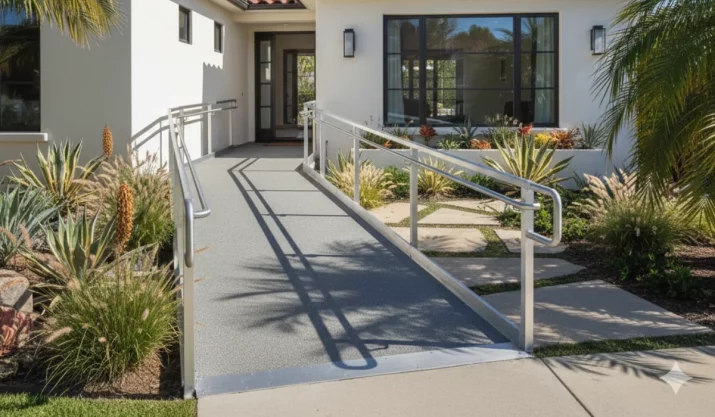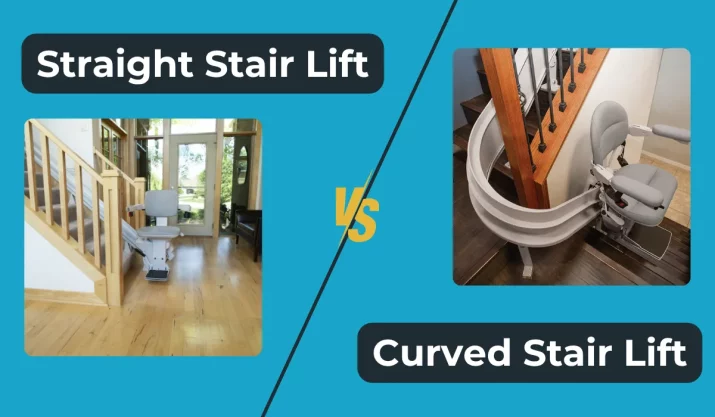Are Portable Ramps Safe for Coastal San Diego Homes?

Table of Contents
- Key Takeaways
- Why Portable Ramps Are Useful in San Diego
- How Coastal Weather Affects Ramp Safety
- Meeting ADA Guidelines for Safe Use
- Understanding the Different Types of Ramps
- Safety Features to Look For
- Keeping Portable Ramps Safe in Coastal Weather
- Are Portable Ramps Right for Your Loved One?
- Making the Right Ramp Choice for Your San Diego Home
- FAQs
Life by the beach in San Diego is beautiful. But salty, moist air can be hard on outdoor items, such as wheelchair ramps.
If you or a loved one uses a ramp every day, you may ask: Are portable ramps safe for coastal San Diego homes?
Yes. Portable ramps are safe when you choose the right materials, install them correctly, and maintain simple care.
This guide explains how portable ramps work, how beach weather affects them, and what to look for when choosing a ramp for your California home.
Key Takeaways
- Portable wheelchair ramps are safe and reliable when made from rust-resistant aluminum.
- Following ADA guidelines ensures a safe slope, width, and ramp length.
- Non-slip surfaces and strong handrails add essential safety features.
- Regular maintenance helps protect ramps from moisture and salt near the coast.
Why Portable Ramps Are Useful in San Diego
Portable ramps help people who use wheelchairs, scooters, or walkers move past small steps at doors, porches, and driveways without a permanent ramp.
They work well in coastal areas such as La Jolla, Mission Beach, and Oceanside, where uneven ground and small curbs are common.
You can fold, carry, and store them, which helps renters and families on the go.
They’re an affordable way to add access without major construction. If you’re wondering if a portable ramp is the right solution for your home, think about how often you need to move mobility devices between indoor and outdoor spaces.
Most portable ramps use aluminum because it is light, strong, and resists rust. Many models hold 800 pounds or more, which fits power chairs and a caregiver.
At California Mobility, we help families choose portable ramps in California that meet their specific needs while improving daily home access.
How Coastal Weather Affects Ramp Safety
Coastal air in San Diego carries salt and moisture that can wear down ramps, so choosing the right materials and surface grip is very important.
Aluminum ramps work well near the ocean. They stay sturdy when wet and use non-slip textures to prevent falls.
Rubber threshold ramps also help with small gaps inside and outside. They create smooth transitions at sliding doors, patios, or step-down entries without a permanent installation.
Wood ramps don’t last well by the coast. They can swell and get slippery.
If you live near the shoreline, rinse ramps with fresh water once a month to remove salt. Regular rinsing helps keep handrails, edges, and surfaces strong.
We can recommend ramp materials and designs that fit local coastal weather.
Meeting ADA Guidelines for Safe Use
The Americans with Disabilities Act (ADA) provides clear rules to make ramps safe for everyone. Following ADA rules keeps ramps stable and easy to use for riders and caregivers.
The ADA guidelines recommend a maximum slope of 1 inch of rise per 12 inches of ramp length. This inch-per-rise rule ensures the ramp isn’t too steep. A gentle slope is easier to climb and safer for power wheelchairs and scooters.
To stay ADA-compliant, a ramp should include:
- Handrails on both sides for extra support.
- Edge protection to stop wheels from slipping off.
- Slip-resistant or non-slip surfaces for safe traction.
- A flat landing at the top and bottom for easier turns.
Whether you’re setting up a single-fold ramp for one step or a longer modular ramp system for multiple stairs, following ADA guidelines ensures long-term safety. These same standards also apply to public spaces, where ramps must provide safe and equal access for everyone.
We handle your ramp installation and make sure every part meets federal standards.
Understanding the Different Types of Ramps
There are several types of ramps available, and choosing the right one depends on your mobility needs, the home’s layout, and the type of wheelchair you use.
- Portable ramps: Easy to fold, store, and move. Perfect for temporary use or travel.
- Threshold ramps: Great for small door lips and entryways. Often made of rubber or aluminum.
- Curb ramps: Designed for sidewalks and driveways to help users move safely over curbs.
- Modular ramps: Built in sections for taller or complex entrances. They can be adjusted and expanded as needed.
- Permanent ramps: Installed for long-term access at homes with larger steps.
When deciding between portable vs. permanent wheelchair ramps, consider how often you’ll need to move it or adjust its setup. Each ramp has its own advantages. Portable ramps give the most flexibility, while modular ramps fit semi-permanent needs. Pick a ramp that fits your routine, space, and safety needs.
We offer a variety of ramps to suit your needs. Our team can help you choose the best ramp for your property and mobility aids, ensuring smooth and safe home access.
Safety Features to Look For
When choosing wheelchair ramps for a San Diego home, safety should be the top priority. According to the Centers for Disease Control and Prevention (CDC), falls are among the leading causes of injury among older adults, making proper ramp setup an essential part of home fall prevention.
Here are key safety features that protect both wheelchair users and caregivers:
- Non-slip surfaces that prevent accidents in wet or sandy conditions.
- Edge protection along both sides to stop wheels from rolling off.
- Handrails that give users extra stability when moving uphill or downhill.
- Proper slope and ramp length that follow ADA guidelines. A clear landing at the foot of the ramp helps users start and stop safely without sudden elevation changes.
- Strong weight capacity for all types of mobility devices, including power chairs and scooters.
These features keep ramps dependable near the ocean, where humidity and sand can cause slips. Check for them during install so the ramp stays safe for years.
Keeping Portable Ramps Safe in Coastal Weather
With simple care, portable ramps can last for years. San Diego’s coastal air leaves a thin salt layer on aluminum, so cleaning matters.
To keep ramps safe and clean:
- Rinse them monthly with fresh water to remove salt.
- Check handrails, bolts, and joints to confirm everything is tight.
- Make sure non-slip surfaces stay textured and firm.
- Keep ramps dry when stored to avoid corrosion.
- Avoid going over the labeled weight capacity to protect the ramp’s structure.
If you notice loose screws or fading traction, contact a technician for maintenance. Regular care helps prevent minor issues from becoming safety problems.
At California Mobility, we provide maintenance and repair support to keep your ramp dependable year-round.
Are Portable Ramps Right for Your Loved One?
Portable ramps can boost safety and independence. They smooth moves over steps and reduce strain on caregivers.
For seniors and other riders, portable ramps add confidence at the door. They may replace a stair lift for a single step or a short-term need, and they help during recovery after injury or surgery.
When choosing a ramp, consider mobility needs, the number of steps, and available space. Expert guidance helps you pick a safe, comfortable fit.
Making the Right Ramp Choice for Your San Diego Home
Every San Diego home has its own layout and mobility needs. The best ramp choice depends on your space, lifestyle, and how often you use it. A professional assessment helps match you with the proper setup for comfort and safety.
At California Mobility, we offer personalized guidance to help you choose a ramp that fits your home and daily routine.
Ready to improve access and independence? Contact us today or request a free quote to schedule a free home visit and learn more about safe, portable ramp options across California.








